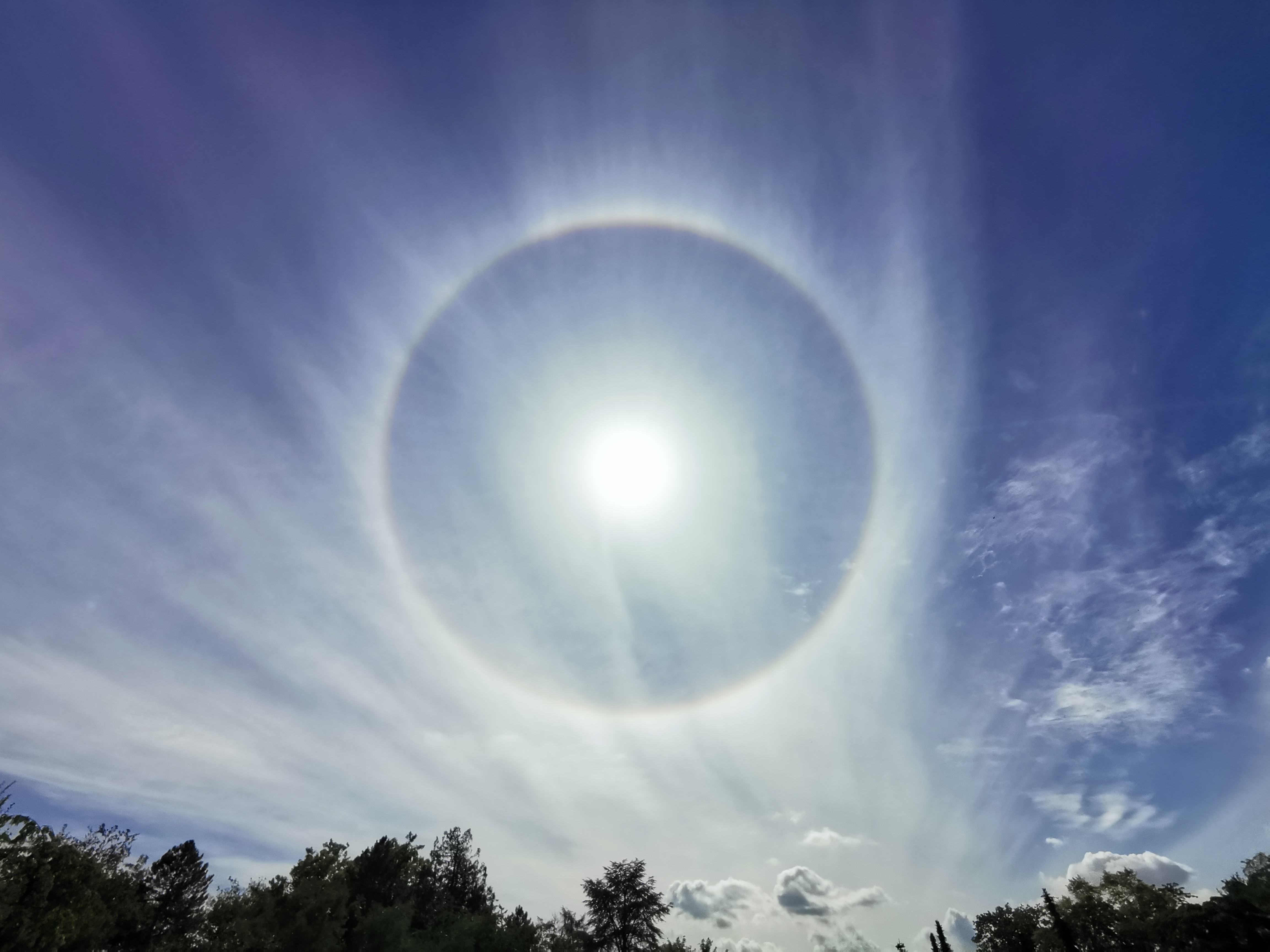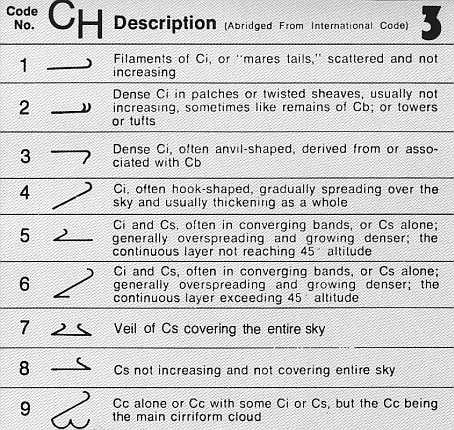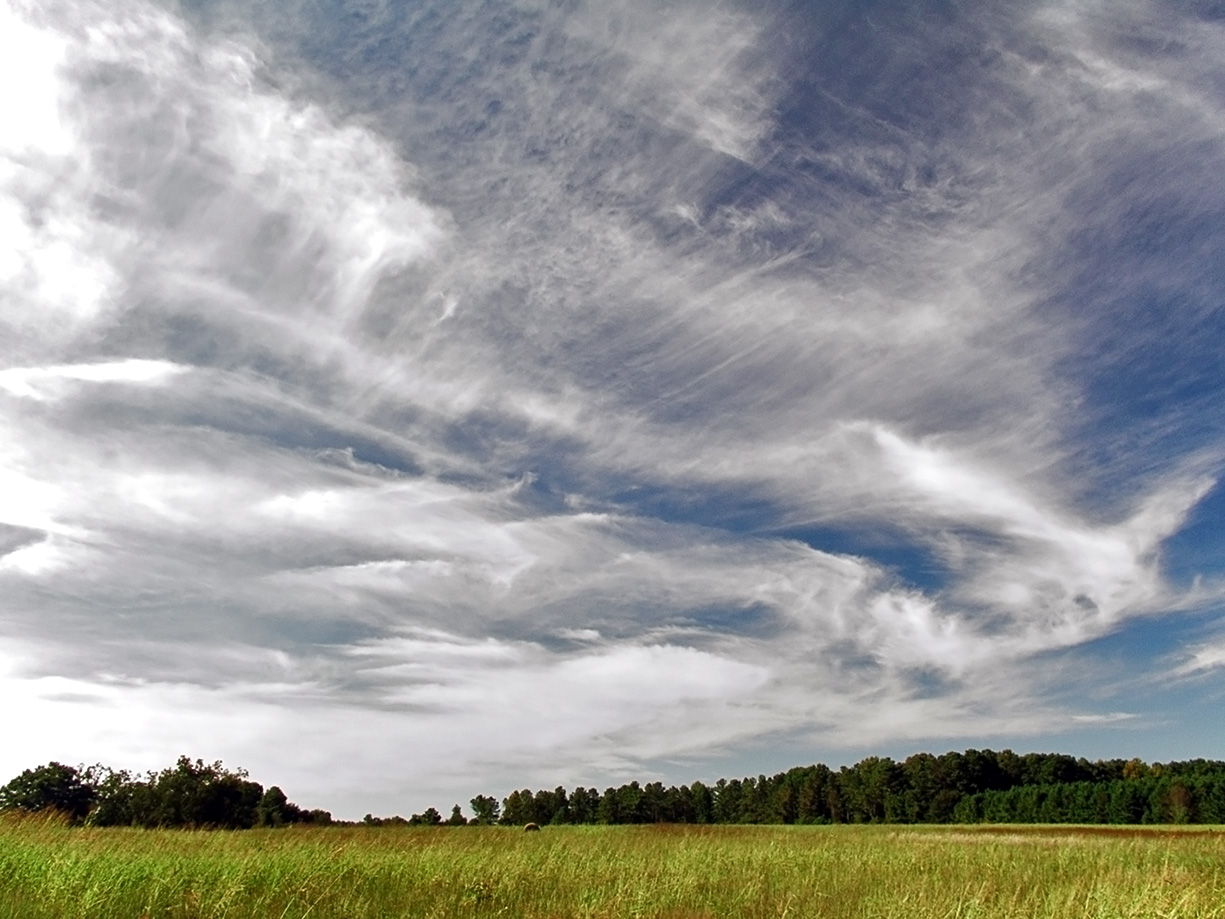|
22° Halo
A 22° halo is an atmospheric optical phenomenon that consists of a halo with an apparent radius of approximately 22° around the Sun or Moon. When visible around the Moon, it is also known as a moon ring or winter halo. It forms as sunlight or moonlight is refracted by millions of hexagonal ice crystals suspended in the atmosphere. Its radius is roughly the length of an outstretched hand at arm's length. Formation Even though it is one of the most common types of halo, the exact shape and orientation of the ice crystals responsible for the 22° halo are the topic of debate. Hexagonal, randomly oriented columns are usually put forward as the most likely candidate, but this explanation presents problems, such as the fact that the aerodynamic properties of such crystals leads them to be oriented horizontally rather than randomly. Alternative explanations include the involvement of clusters of bullet-shaped ice columns. As light passes through the 60° apex angle of the hexag ... [...More Info...] [...Related Items...] OR: [Wikipedia] [Google] [Baidu] |
Refractive Index
In optics, the refractive index (or refraction index) of an optical medium is a dimensionless number that gives the indication of the light bending ability of that medium. The refractive index determines how much the path of light is bent, or refracted, when entering a material. This is described by Snell's law of refraction, , where ''θ''1 and ''θ''2 are the angle of incidence and angle of refraction, respectively, of a ray crossing the interface between two media with refractive indices ''n''1 and ''n''2. The refractive indices also determine the amount of light that is reflected when reaching the interface, as well as the critical angle for total internal reflection, their intensity ( Fresnel's equations) and Brewster's angle. The refractive index can be seen as the factor by which the speed and the wavelength of the radiation are reduced with respect to their vacuum values: the speed of light in a medium is , and similarly the wavelength in that medium is , wher ... [...More Info...] [...Related Items...] OR: [Wikipedia] [Google] [Baidu] |
Moon Dog
A moon dog (or moondog) or mock moon, also called a paraselene (plural paraselenae) in meteorology, is an atmospheric optical phenomenon that consists of a bright spot to one or both sides of the Moon. They are exactly analogous to sun dogs. Moon dogs are caused by the refraction of moonlight by hexagonal-plate-shaped ice crystals in cirrus or cirrostratus clouds. They typically appear as a pair of faint patches of light, at around 22° to the left and right of the Moon, and at the same altitude above the horizon as the Moon. They may also appear alongside 22° halos. Moon dogs are rarer than sun dogs because the Moon must be bright, about quarter moon or more, for the moon dogs to be observed. Moon dogs show little color to the unaided human eye because their light is not bright enough to activate the eye's cone cells. See also * Halo (optical phenomenon) * Circumhorizontal arc * Circumzenithal arc * Gegenschein * Zodiacal light The zodiacal light (also called false daw ... [...More Info...] [...Related Items...] OR: [Wikipedia] [Google] [Baidu] |
Sun Dog
A sun dog (or sundog) or mock sun, also called a parhelion (plural parhelia) in meteorology, is an atmospheric optical phenomenon that consists of a bright spot to one or both sides of the Sun. Two sun dogs often flank the Sun within a 22° halo. The sun dog is a member of the family of halos caused by the refraction of sunlight by ice crystals in the atmosphere. Sun dogs typically appear as a pair of subtly colored patches of light, around 22° to the left and right of the Sun, and at the same altitude above the horizon as the Sun. They can be seen anywhere in the world during any season, but are not always obvious or bright. Sun dogs are best seen and most conspicuous when the Sun is near the horizon. Formation and characteristics Sun dogs are commonly caused by the refraction and scattering of light from horizontally oriented plate-shaped hexagonal ice crystals either suspended in high and cold cirrus or cirrostratus clouds, or drifting in freezing moist air at ... [...More Info...] [...Related Items...] OR: [Wikipedia] [Google] [Baidu] |
Circumhorizontal Arc
A circumhorizontal arc is an optical phenomenon that belongs to the family of ice halos formed by the refraction of sunlight or moonlight in plate-shaped ice crystals suspended in the atmosphere, typically in cirrus or cirrostratus clouds. In its full form, the arc has the appearance of a large, brightly spectrum-coloured band (red being the topmost colour) running parallel to the horizon, located far below the Sun or Moon. The distance between the arc and the Sun or Moon is twice as far as the common 22-degree halo. Often, when the halo-forming cloud is small or patchy, only fragments of the arc are seen. As with all halos, it can be caused by the Sun as well as (but much more rarely) the Moon. Other currently accepted names for the circumhorizontal arc are circumhorizon arc or lower symmetric 46° plate arc. The misleading term "fire rainbow" is sometimes used to describe this phenomenon, although it is neither a rainbow, nor related in any way to fire. The term, apparently ... [...More Info...] [...Related Items...] OR: [Wikipedia] [Google] [Baidu] |
Circumzenithal Arc
The circumzenithal arc, also called the circumzenith arc (CZA), upside-down rainbow, and the Bravais arc,"Mémoire sur les halos et les phénomènes optiques qui les accompagnent", J. de l' École Royale Polytechnique 31(18), 1-270, A. Bravais, 1847 is an optical phenomenon similar in appearance to a rainbow, but belonging to the family of halos arising from refraction of sunlight through ice crystals, generally in cirrus or cirrostratus clouds, rather than from raindrops. The arc is located at a considerable distance (approximately 46°) above the observed Sun and at most forms a quarter of a circle centered on the zenith. It has been called "a smile in the sky", its first impression being that of an upside-down rainbow. The CZA is one of the brightest and most colorful members of the halo family. Its colors, ranging from violet on top to red at the bottom, are purer than those of a rainbow because there is much less overlap in their formation. The intensity distribution ... [...More Info...] [...Related Items...] OR: [Wikipedia] [Google] [Baidu] |
46° Halo
A 46° halo is a rare atmospheric optical phenomenon that consists of a halo with an apparent radius of approximately 46° around the Sun. At solar elevations of 15–27°, 46° halos are often confused with the less rare and more colourful supralateral and infralateral arcs, which cross the parhelic circle at about 46° to the left and right of the sun.The 46° halo was first explained as being caused by refractions through ice crystals in 1679 by the French physicist Edmé Mariotte (1620–1684). See: Mariotte, ''Quatrieme Essay. De la Nature des Couleur'' (Paris, France: Estienne Michallet, 1681). Sun dogs as well as the 22° and 46° halos are explained in terms of refractions from ice crystals opages 466–524 The 46° halo is similar to, but much larger and fainter than, the more common 22° halo. The 46° halo forms when sunlight enters randomly oriented hexagonal ice crystals through a prism face and exits through a hexagonal base. The 90° inclination between the t ... [...More Info...] [...Related Items...] OR: [Wikipedia] [Google] [Baidu] |
Cirrostratus Cloud
Cirrostratus is a high-level, very thin, generally uniform ''stratiform'' genus-type of cloud. It is made out of ice-crystals, which are pieces of frozen water. It is difficult to detect and it can make halos. These are made when the cloud takes the form of thin cirrostratus nebulosus. The cloud has a fibrous texture with no halos if it is thicker cirrostratus fibratus. On the approach of a frontal system, the cirrostratus often begins as nebulous and turns to fibratus. If the cirrostratus begins as fragmented of clouds in the sky it often means the front is weak. Cirrostratus is usually located above 5.5 km (18,000 ft). Its presence indicates a large amount of moisture in the upper troposphere. Clouds resembling cirrostratus occasionally form in polar regions of the lower stratosphere. Polar stratospheric clouds can take on this appearance when composed of tiny supercooled droplets of water or nitric acid. Cirrostratus clouds sometimes signal the approach of a wa ... [...More Info...] [...Related Items...] OR: [Wikipedia] [Google] [Baidu] |
Cirrus Cloud
Cirrus ( cloud classification symbol: Ci) is a genus of high cloud made of ice crystals. Cirrus clouds typically appear delicate and wispy with white strands. Cirrus are usually formed when warm, dry air rises, causing water vapor deposition onto rocky or metallic dust particles at high altitudes. Globally, they form anywhere between above sea level, with the higher elevations usually in the tropics and the lower elevations in more polar regions. Cirrus clouds can form from the tops of thunderstorms and tropical cyclones and sometimes predict the arrival of rain or storms. Although they are a sign that rain and maybe storms are on the way, cirrus themselves drop no more than falling streaks of ice crystals. These crystals dissipate, melt, and evaporate as they fall through warmer and drier air and never reach ground. Cirrus clouds warm the earth, potentially contributing to climate change. A warming earth will likely produce more cirrus clouds, potentially resulting in a sel ... [...More Info...] [...Related Items...] OR: [Wikipedia] [Google] [Baidu] |
Folklore
Folklore is shared by a particular group of people; it encompasses the traditions common to that culture, subculture or group. This includes oral traditions such as tales, legends, proverbs and jokes. They include material culture, ranging from traditional building styles common to the group. Folklore also includes customary lore, taking actions for folk beliefs, the forms and rituals of celebrations such as Christmas and weddings, folk dances and initiation rites. Each one of these, either singly or in combination, is considered a folklore artifact or traditional cultural expression. Just as essential as the form, folklore also encompasses the transmission of these artifacts from one region to another or from one generation to the next. Folklore is not something one can typically gain in a formal school curriculum or study in the fine arts. Instead, these traditions are passed along informally from one individual to another either through verbal instruction or demons ... [...More Info...] [...Related Items...] OR: [Wikipedia] [Google] [Baidu] |




_in_the_Nepal_Himalayas.jpg)
.jpg)


